Canon ZR65 MC, ZR70 MC, ZR60 User Manual
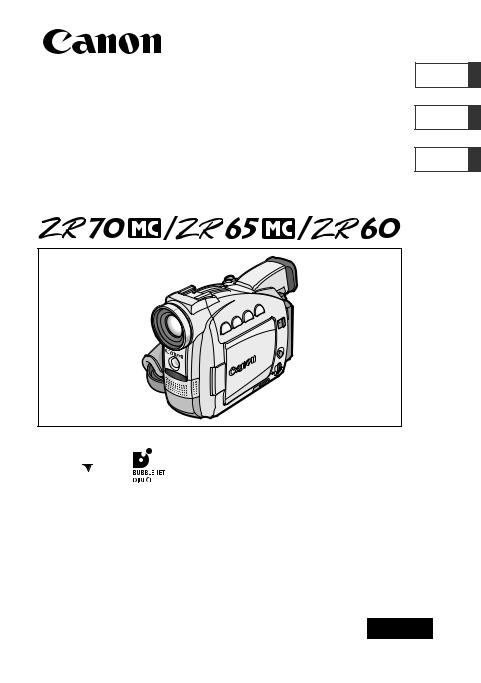
PUB.DIM-519
Digital Video Camcorder
Instruction Manual English
Camescope vidéo numérique
Manuel d’instruction Français
Videocámara digital
Manual de Instrucciones Español
Mini Digital
Digital
Video
Cassette
This instruction manual covers the ZR70 MC, ZR65 MC and ZR60. Please note that illustrations and explanation in this manual are based on the ZR70 MC.
Ce manuel d’instruction traite des modèles ZR70 MC, ZR65 MC et ZR60. Veuillez noter que les illustrations et les explications contenues dans ce manuel sont basées sur le ZR70 MC.
Este manual de instrucciones cubre la ZR70 MC, la ZR65 MC, y la ZR60. Tenga en cuenta que las ilustraciones y las explicaciones de este manual se basan en la ZR70 MC.
NTSC
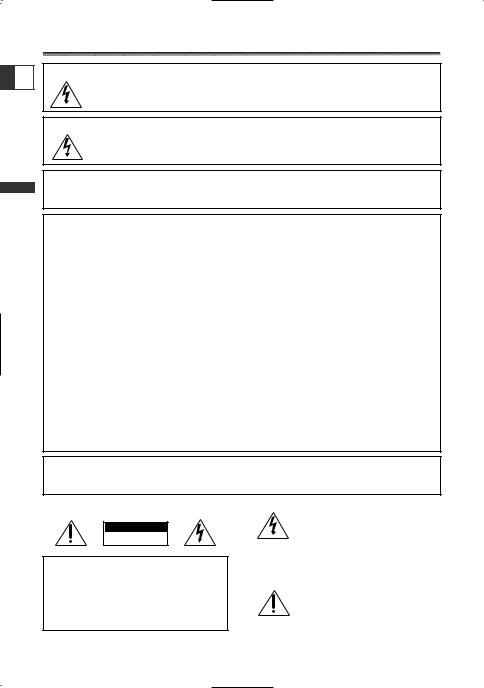
Important Usage Instructions
E
Introduction
WARNING:
TO REDUCE THE RISK OF FIRE OR ELECTRIC SHOCK, DO NOT EXPOSE THIS PRODUCT TO RAIN OR MOISTURE.
WARNING:
TO REDUCE THE RISK OF ELECTRIC SHOCK AND TO REDUCE ANNOYING INTERFERENCE, USE THE RECOMMENDED ACCESSORIES ONLY.
COPYRIGHT WARNING:
Unauthorized recording of copyrighted materials may infringe on the rights of copyright owners and be contrary to copyright laws.
Digital Video Camcorder, ZR70 MC/ZR65 MC/ZR60 systems
This device complies with Part 15 of the FCC Rules. Operation is subject to the following two conditions: (1) This device may not cause harmful interference, and (2) this device must accept any interference received, including interference that may cause undesired operation.
Note: This equipment has been tested and found to comply with the limits for class B digital device, pursuant to Part 15 of the FCC Rules. These limits are designed to provide reasonable protection against harmful interference in a residential installation. This equipment generates, uses and can radiate radio frequency energy and, if not installed and use in accordance with the instructions, may cause harmful interference to radio communications. However, there is no guarantee that interference will not occur in a particular installation. If this equipment does cause harmful interference to radio or television reception, which can be determined by turning the equipment off and on, the user is encouraged to try to correct the interference by one or more of the following measures:
•Reorient or relocate the receiving antenna.
•Increase the separation between the equipment and receiver.
•Connect the equipment into an outlet on a circuit different from that to which the receiver is connected.
•Consult the dealer or an experienced radio/TV technician for help.
Use of shielded cable is required to comply with class B limits in Subpart B of Part 15 of FCC Rules.
Do not make any changes or modifications to the equipment unless otherwise specified in the manual.
If such changes or modifications should be made, you could be required to stop operation of the equipment.
Canon U.S.A. Inc.
One Canon Plaza, Lake Success, NY 11042, U.S.A.
Tel No. (516)328-5600
CAUTION:
TO PREVENT ELECTRIC SHOCK, MATCH WIDE BLADE OF PLUG TO WIDE SLOT, FULLY INSERT.
Important Warning
CAUTION
RISK OF ELECTRIC SHOCK
DO NOT OPEN
CAUTION:
TO REDUCE THE RISK OF ELECTRIC SHOCK, DO NOT REMOVE COVER (OR BACK). NO USER-SERVICEABLE PARTS INSIDE. REFER SERVICING TO QUALIFIED SERVICE PERSONNEL.
The lightning flash with arrowhead symbol, within an equilateral triangle, is intended to alert the user to the presence of uninsulated “dangerous voltage” within the product’s enclosure, that may be of sufficient magnitude to constitute a risk of electric shock to persons.
The exclamation point, within an equilateral triangle, is intended to alert the user to the presence of important operating and maintenance (servicing) instructions in the literature accompanying the product.
2

IMPORTANT SAFETY INSTRUCTIONS
In these safety instructions the word “product” refers to the Canon Digital Video Camcorder ZR70 MC/ZR65 MC/ZR60 A and all its accessories.
1.Read Instructions — All the safety and operating instructions should be read before the product is operated.
2.Retain Instructions — The safety and operating instructions should be retained for future reference.
3.Heed Warnings — All warnings on the product and in the operating instructions should be adhered to.
4.Follow Instructions — All operating and maintenance instructions should be followed.
5.Cleaning — Unplug this product from the wall outlet before cleaning. Do not use liquid or aerosol cleaners. The product should be cleaned only as recommended in this manual.
6.Accessories — Do not use accessories not recommended in this manual as they may be hazardous.
7.Avoid magnetic or electric fields — Do not use the camera close to TV transmitters, portable communication devices or other sources of electric or magnetic radiation. They may cause picture interference, or permanently damage the camera.
8.Water and Moisture — Hazard of electric shock — Do not use this product near water or in rainy/moist situations.
9.Placing or Moving — Do not place on an unstable cart, stand, tripod, bracket or table. The product may fall, causing serious
injury to a child or adult, and serious damage to the product.
A product and cart
combination should be moved with care. Quick
stops, excessive force, and uneven surfaces may cause the product and cart combination to overturn.
10.Power Sources — The CA-570 Compact Power Adapter should be operated only from the type of power source indicated on the marking label. If you are not sure of the type of power supply to your home, consult your product dealer or local power company. Regarding other power sources such as battery power, refer to instructions in this manual.
11.Polarization — The CA-570 Compact Power Adapter is equipped with a polarized 2- prong plug (a plug having one blade wider than the other).
The 2-prong polarized plug will fit into the power outlet only one way. This is a safety feature. If you are unable to insert the plug fully into the outlet, try reversing the plug. If the plug still fails to fit, contact your electrician to replace your obsolete outlet. Do not defeat the safety purpose of the polarized plug.
12.Power Cord Protection — Power cords should be routed so that they are not likely to be walked on or pinched by items placed upon or against them. Pay particular attention to plugs and the point from which the cords exit the product.
13.Outdoor Antenna Grounding — If an outside antenna is connected to the product, be sure the antenna is grounded so as to provide some protection against voltage surges and built-up static charges. Section 810 of the National Electrical Code, ANSI / NFPA No. 70—1984, provides information with respect to proper grounding of the mast and supporting structure, grounding of the lead-in wire to an antenna discharge unit, size of grounding conductors, location of antenna discharge unit, connection to grounding electrodes, and requirements for the grounding electrode. See figure 1.
E
Introduction
3
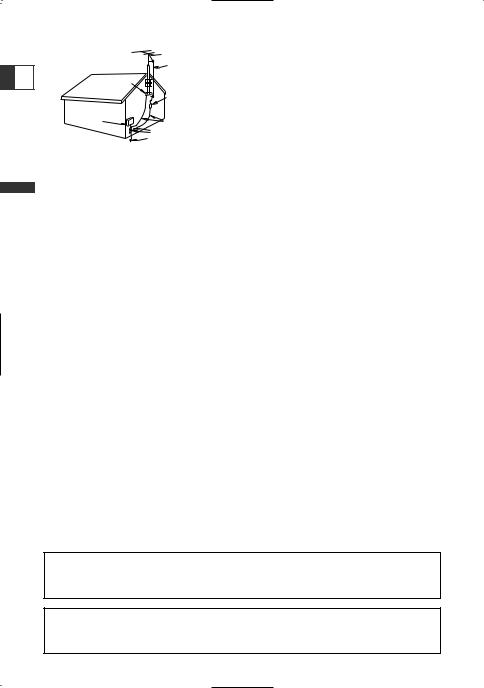
Fig. 1 |
EXAMPLE OF ANTENNA GROUNDING AS |
PER NATIONAL ELECTRICAL CODE |
|
|
ANTENNA |
|
LEAD IN |
E |
WIRE |
GROUND |
|
CLAMP |
|
|
ANTENNA |
|
DISCHARGE |
|
UNIT |
|
(NEC SECTION |
|
810-20) |
ELECTRIC |
|
SERVICE |
|
EQUIPMENT |
GROUNDING CONDUCTORS |
|
(NEC SECTION 810-21) |
|
GROUND CLAMPS |
|
POWER SERVICE |
|
GROUNDING ELECTRODE |
|
SYSTEM |
|
(NEC ART 250. PART H) |
NEC - NATIONAL ELECTRICAL CODE |
|
14. Lightning — For added protection of this product during a lightning storm, or when
it is left unattended and unused for long Introduction
periods of time, disconnect it from the wall outlet and disconnect the antenna. This will prevent damage to the product due to lightning and power-line surges.
15. Overloading — Do not overload wall outlets and extension cords as this can result in a risk of fire or electric shock.
16. Objects and Liquid Entry — Never push objects of any kind into this product through openings as they may touch dangerous voltage points or short out parts that could result in a fire or electric shock. Be careful not to spill liquid of any kind onto the product.
17. Servicing — Do not attempt to service this product yourself as opening or removing covers may expose you to dangerous voltage or other hazards. Refer all servicing to qualified service personnel.
18.Damage Requiring Service — Disconnect this product from the wall outlet and all power sources including battery, and refer servicing to qualified service personnel under the following conditions:
a.When the power-supply cord or plug is damaged.
b.If any liquid has been spilled onto, or objects have fallen into, the product.
c.If the product has been exposed to rain or water.
d.If the product does not operate normally even if you follow the operating instructions. Adjust only those controls that are covered by the operation instructions. Improper adjustment of other controls may result in damage and will often require extensive work by a qualified technician to restore the product to its normal operation.
e.If the product has been dropped or the cabinet has been damaged.
f.When the product exhibits a distinct change in performance. This indicates a need for service.
19.Replacement Parts — When replacement parts are required, be sure the service technician has used replacement parts that are specified by Canon or that have the same characteristics as the original part. Unauthorized substitutions may result in fire, electric shock or other hazards.
20.Safety Check — Upon completion of any service or repairs to this product, ask the service technician to perform safety checks to determine that the product is in safe operating order.
When replacement of power supply is required, please return it to the responsible nearest Canon Service Center and please replace it with the same type number CA-570.
The Adapter can be used with a power supply between 100 and 240 V AC. For areas where 120 V AC power is not used, you will need a special plug adapter. Contact your nearest Canon Service Center for further information.
4

Reference Guide
The following manuals are supplied with the camcorder:
Digital Video Camcorder ZR70 MC/ZR65 MC/ZR60 Instruction Manual
This manual explains the camcorder operations from basic video recording to the use of the full range of features.
Windows XP Users Only
DV NETWORK SOLUTION DISK Software Instruction Manual
This manual explains how to download/upload images from/to the memory card using a DV (IEEE1394) cable. You can also perform videoconference and file transfer over the Internet using the provided software. Available functions depend upon the camcorder model and networking environment.
ZR70 MC ZR65 MC
DIGITAL VIDEO SOLUTION DISK Software Instruction Manual
This manual explains how to download images from the memory card to a computer using the supplied USB cable. You can add sample images for Card Mix and My Camera settings from the supplied DIGITAL VIDEO SOLUTION DISK.
E
Introduction
Trademark Acknowledgements
•Canon is a registered trademark of Canon Inc.
•D is a trademark.
•
 logo is a trademark.
logo is a trademark.
•Macintosh is a trademark of Apple Computer Inc., registered in the United States and other countries.
•Windows® is either a registered trademark or trademark of Microsoft Corporation in the United States and/or other countries.
•Other names and products not mentioned above may be registered trademarks or trademarks of their respective companies.
5

E
Introduction
Table of Contents |
|
Introduction |
|
Reference Guide .............................................................................................................. |
5 |
Thank You for Choosing a Canon ................................................................................ |
9 |
Introducing the ZR70 MC/ZR65 MC/ZR60 .................................................................. |
10 |
Components Guide ...................................................................................................... |
11 |
Mastering the Basics |
|
Preparations |
|
Using a Household Power Source .............................................................................. |
15 |
Attaching and Charging the Battery Pack ................................................................ |
16 |
Installing the Backup Battery ...................................................................................... |
19 |
Preparing the Camcorder ............................................................................................ |
20 |
Loading a Cassette ........................................................................................................ |
22 |
Using the Wireless Controller...................................................................................... |
24 |
Setting the Time Zone, Date and Time ...................................................................... |
25 |
Basic Recording |
|
Recording Movies on a Tape ...................................................................................... |
28 |
Zooming ........................................................................................................................ |
30 |
Using the LCD Screen.................................................................................................... |
32 |
Searching and Reviewing when Recording .............................................................. |
35 |
Tips for Making Better Videos .................................................................................... |
36 |
Basic Playback |
|
Playing Back a Tape ...................................................................................................... |
37 |
Playing Back on a TV Screen........................................................................................ |
41 |
Using the Full Range of Features |
|
General |
|
Menus and Settings ...................................................................................................... |
44 |
Changing the Remote Sensor Mode .......................................................................... |
49 |
Customizing the Camcorder ........................................................................................ |
50 |
ZR70 MC Setting the Light-up Buttons ........................................................................ |
51 |
Other Camcorder Settings .......................................................................................... |
52 |
Recording |
|
Changing the Recording Mode (SP/LP) ...................................................................... |
54 |
Recording Still Images on a Tape................................................................................ |
55 |
Using the Recording Programs.................................................................................... |
57 |
Using Digital Effects...................................................................................................... |
61 |
Using the Multi-Image Screen .................................................................................... |
67 |
Turning Off the Image Stabilizer ................................................................................ |
69 |
Recording With the Self-Timer.................................................................................... |
70 |
Audio Recording .......................................................................................................... |
71 |
ZR70 MC Using the VL-3 Video Light (Optional) ........................................................ |
73 |
ZR70 MC Using the DM-50 Microphone (Optional).................................................... |
74 |
Manual Adjustments |
|
Adjusting the Focus Manually .................................................................................... |
75 |
6

Adjusting the AE Shift .................................................................................................. |
77 |
Setting the Shutter Speed............................................................................................ |
78 |
Setting the White Balance .......................................................................................... |
80 |
Playback |
|
Magnifying the Image.................................................................................................. |
82 |
Displaying the Data Code ............................................................................................ |
83 |
Photo Search/Date Search............................................................................................ |
85 |
Returning to a Pre-marked Position .......................................................................... |
86 |
Editing |
|
Recording to a VCR or Digital Video Device ............................................................ |
87 |
Recording from Analog Video Devices (VCR, TV or Camcorder) .......................... |
89 |
Recording from Digital Video Devices (DV Dubbing).............................................. |
90 |
Converting Analog Signals into Digital Signals (Analog-Digital Converter) ........ |
92 |
Replacing Existing Scenes (AV Insert) ........................................................................ |
94 |
Audio Dubbing.............................................................................................................. |
96 |
Connecting to a Computer Using a DV (IEEE1394) Cable ...................................... |
99 |
ZR70 MC ZR65 MC Using a Memory Card |
|
Inserting and Removing the Memory Card ............................................................ |
100 |
Selecting the Image Quality/Size .............................................................................. |
101 |
Recording Still Images on a Memory Card.............................................................. |
104 |
Recording Panoramic Images (Stitch Assist Mode) ................................................ |
107 |
ZR70 MC Recording Motion JPEG Movies on a Memory Card................................ |
109 |
Playing Back a Memory Card .................................................................................... |
111 |
Protecting Images ...................................................................................................... |
114 |
Erasing Images ............................................................................................................ |
115 |
Selecting Still Images for Printing (Print Order) .................................................... |
116 |
Printing with the Direct Print Function.................................................................... |
118 |
Combining Images (Card Mix) .................................................................................. |
122 |
Copying Still Images.................................................................................................... |
126 |
Formatting a Memory Card ...................................................................................... |
128 |
Connecting to a Computer Using a USB Cable ...................................................... |
129 |
Creating a Start-up Image ........................................................................................ |
130 |
Memory Card Information ........................................................................................ |
131 |
Additional Information |
|
Screen Displays ............................................................................................................ |
134 |
List of Messages .......................................................................................................... |
138 |
Maintenance................................................................................................................ |
141 |
Troubleshooting .......................................................................................................... |
145 |
System Diagram .......................................................................................................... |
148 |
Optional Accessories .................................................................................................. |
149 |
Specifications .............................................................................................................. |
152 |
Index ............................................................................................................................ |
154 |
E
Introduction
7

Conventions Used in This Manual
Operating Modes
|
E |
|
|
|
|
|
|
Operating Mode |
Position of the |
Position of the |
|
|
|
|
POWER Switch |
TAPE/CARD Switch |
|
|
|
|
|
||
|
|
|
CAMERA |
CAMERA |
TAPE |
|
|
|
PLAY (VCR) |
PLAY (VCR) |
TAPE |
|
|
|
CARD CAMERA |
CAMERA |
CARD |
|
|
|
CARD PLAY (VCR) |
PLAY (VCR) |
CARD |
|
|
|
|
|
|
Shaded area : ZR70 MC and ZR65 MC only.
Introduction
Available functions depend upon the operating mode. It is indicated as follows:
CAMERA : Function can be used in this mode.
CAMERA |
: Function cannot be used in this mode. |
Other Symbols and References
 : Reference page number.
: Reference page number.
 : Functions to be operated on the body of the camcorder.
: Functions to be operated on the body of the camcorder.
 : Functions to be operated on the wireless controller.
: Functions to be operated on the wireless controller.
 : Additional topics that complement the basic operating procedures.
: Additional topics that complement the basic operating procedures.
 : Precautions related to the camcorder operation.
: Precautions related to the camcorder operation.
Capital letters are used to refer to buttons on the camcorder or the wireless controller.
[ ] are used to refer to menu items displayed on the screen.
“Screen” refers to the LCD and the viewfinder screen.
The serial number of this product can be found at the battery attachment unit of the camcorder. Write down the number and other information here and retain this book as a permanent record of your purchase to aid identification in case of theft.
Date of Purchase: |
Model Name: ZR70 MC/ZR65 MC/ZR60 |
Purchased From: |
Serial No.: |
Dealer Address: |
|
Dealer Phone No.: |
|
8

Thank You for Choosing a Canon
The Canon ZR70 MC/ZR65 MC/ZR60 provides a full range of options and functions. We
recommend reading this manual thoroughly before you use the camcorder. It will help you to become more familiar with your camcorder, and learn how to operate it properly.
E
We suggest that you master the basic operations of the camcorder first, before moving on to its full range of features.
Checking Supplied Accessories |
|
|
||||
ZR70 MC |
ZR65 MC |
Two AA Batteries |
Lens Cap and Lens |
SS-800 Shoulder Strap |
||
WL-D79 Wireless Controller, |
|
|
Cap Cord |
|
||
ZR60 |
WL-D80 Wireless |
|
|
|
|
|
Controller |
|
|
|
|
|
|
Lithium Button |
ZR70 MC |
BP-512 |
CA-570 Compact |
ZR70 MC WA-30.5 |
||
Battery CR1616 |
Power Adapter (incl. |
|||||
Battery Pack, |
Wide Attachment |
|||||
|
|
ZR65 MC |
ZR60 |
power cord) |
|
|
|
|
BP-508 Battery Pack |
|
|
||
STV-250N Stereo |
ZR70 MC |
ZR65 MC |
ZR70 MC ZR65 MC |
ZR70 MC ZR65 MC |
||
Video Cable |
IFC-300PCU USB Cable |
SDC-8M SD Memory |
Hard Case for SD |
|||
|
|
|
|
Card (containing |
Memory Card |
|
|
|
|
|
sample images) |
|
|
DV NETWORK |
|
|
|
|
||
SOLUTION DISK |
|
|
|
|
||
ZR70 MC |
ZR65 MC |
|
|
|
|
|
DIGITAL VIDEO |
|
|
|
|
||
SOLUTION DISK |
|
|
|
|
||
Introduction
9

E
Introduction
Introducing the ZR70 MC/ZR65 MC/ZR60
22× Optical and
440× Digital Zoom (ZR70 MC)
20× Optical and
400× Digital Zoom (ZR65 MC)
18× Optical and
360× Digital Zoom (ZR60)
Image Stabilizer
Stabilizes your recordings even in long telephoto shots (in Camera mode).
Advanced Accessory Shoe
(ZR70 MC)
Simply slide Canon’s DM-50 Directional Stereo Microphone or VL-3 Video Light into the accessory shoe; the camcorder will automatically provide power and connections.
Digital Effects
Show your creativity by using the special effects and faders. The multi-image screen captures moving subjects in 4, 9 or 16 sequences of still images.
Night Mode
Allows recording even in dark places. The Night mode adjusts automatically to the optimum shutter speed.
Super Night Mode and
Low Light Plus Mode (ZR70 MC)
With the ZR70 MC’s Super Night mode (in Camera mode) and Low Light Plus mode (in Card Camera mode), you can keep on shooting without turning the lights on. The assist lamp (White LED) lights up to illuminate the subject.
Still Images
Just press the photo button to capture still images like photographs.
Memory Card (ZR70 MC/ZR65 MC)
You can record images on a SD Memory Card or MultiMediaCard. Images recorded in Stitch Assist mode can be merged into one panoramic scene with the supplied software.
Direct Print (ZR70 MC/ZR65 MC)
You can print still images by connecting to a Canon Bubble Jet Printer with Direct Print function.
USB Terminal (ZR70 MC/ZR65 MC)
Allows transfer of memory card data to a computer with built-in USB port. You can organize and edit images on your computer using the supplied software.
My Camera Settings
You can personalize your camcorder by customizing the start-up image and camcorder sounds.
Analog Line-in Recording/
Audio Dubbing/AV Insert Editing
IEEE1394 DV Terminal
The DV terminal allows high-quality transfer with virtually no deterioration in quality of images. You can edit images by connecting the camcorder to a PC with IEEE1394 terminal. Windows XP Users can use the supplied software to perform videoconference and file transfer over the Internet.
10
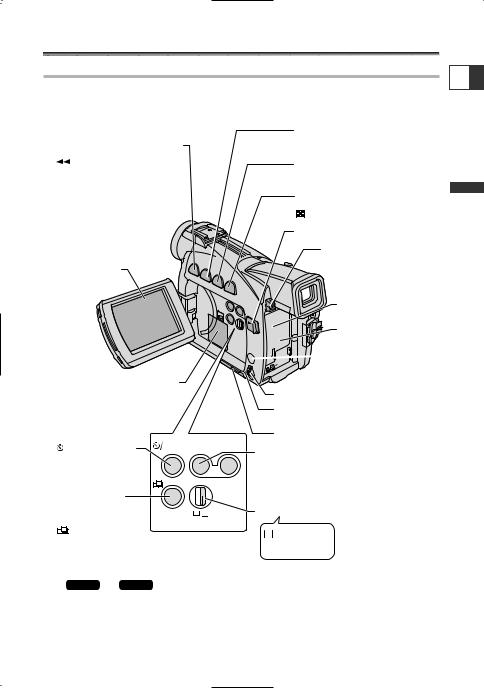
Components Guide
ZR70 MC/ZR65 MC/ZR60 |
E |
|
REC (record) SEARCH – button (p. 35) /  Record review button (p. 35) /
Record review button (p. 35) /
(rewind) button (p. 37) / CARD – button* (p. 111)
LCD screen (p. 32)
Backup battery cover (p. 19)
(self-timer) button |
DATA |
|
CODE |
||
(p. 70) / |
|
|
DATA CODE button |
|
|
(p. 83) |
|
|
Card MIX button* |
|
|
(p. 124) / |
MIX/ |
|
SLIDE SHOW button* |
||
(p. 112)/ |
SLIDE |
|
SHOW |
||
(stitch assist) button* |
||
|
||
(p. 107) |
|
* ZR70 MC and ZR65 MC only.
REC SEARCH + button (p. 35) /
 (fast forward) button (p. 37) /
(fast forward) button (p. 37) /
CARD + button* (p. 111)
FOCUS button (p. 75) /  (play/pause) button (p. 37)
(play/pause) button (p. 37)
AE SHIFT button (p. 77) /  (stop) button (p. 37) /
(stop) button (p. 37) /
|
(index screen) button* (p. 112) |
|
LCD panel OPEN button (p. 32) |
|
BATT. (battery release) |
|
button (p. 16) |
|
Serial number |
1234 5678 9 |
Battery attachment unit |
(p. 16)

 MENU button (p. 44)
MENU button (p. 44)
 DC IN terminal (p. 15)
DC IN terminal (p. 15)
Selector dial (p. 40, 44)
Card access indicator* (p. 104) /
CHARGE indicator (p. 16)
Memory card slot* (p. 100)
DIGITAL
EFFECTS ON/OFF DIGITAL EFFECTS button (p. 61)
 Digital effects ON/OFF button (p. 61)
Digital effects ON/OFF button (p. 61)
PProgram selector (p. 57)
P Program AE
 Easy recording
Easy recording
Introduction
11
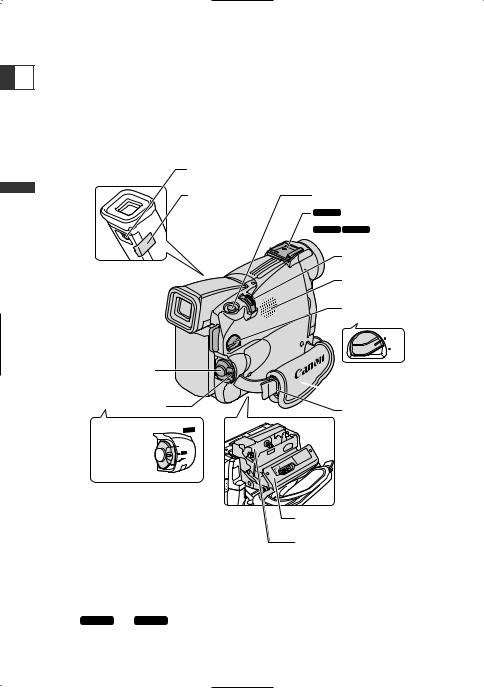
E
Introduction
Diopter adjustment lever (p. 20)
Viewfinder protect cover (p. 142)
Viewfinder (p. 20) 
Strap mount (p. 21) 

Start/stop button (p. 28)
POWER switch (p. 8)
CAMERA |
POWER |
|
|
OFF |
CAMERA |
OFF |
|
PLAY(VCR)} |
PLAY |
(VCR) |
|
|
PHOTO button (p. 55, 104)
ZR70 MC Advanced accessory shoe (p. 73)
ZR65 MC ZR60 Accessory shoe (p. 150)
Zoom lever (p. 30)
Built-in speaker (p. 39)
TAPE/CARD switch* (p. 8)
TAPE
CARD
 Grip belt (p. 20)
Grip belt (p. 20)
Strap mount (p. 21)
Cassette compartment cover (p. 22)
Cassette compartment (p. 22)
* ZR70 MC and ZR65 MC only.
12
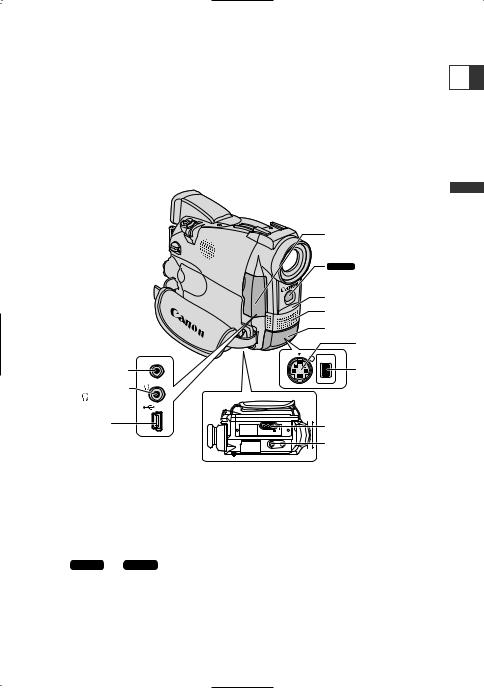
E
MIC
MIC terminal (p. 71)
AV
AV IN/OUT terminal (p. 41) / (phones) terminal (p. 39)
USB terminal * (p. 129)
Terminal cover
ZR70 MC : Assist lamp (White LED) (p. 59)
Remote sensor (p. 24)
Stereo microphone (p. 71)
Terminal cover |
S-video IN/OUT terminal (p. 41)
SDV
DV IN/OUT terminal (p. 87)
Bottom view
OPEN/EJECT switch (p. 22) |
Tripod socket (p. 36) |
Introduction
* ZR70 MC and ZR65 MC only.
13
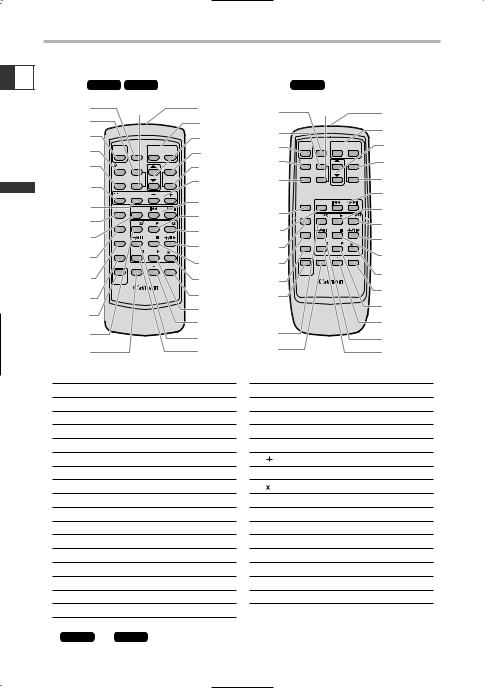
E
Introduction
Wireless Controller
ZR70 MC ZR65 MC WL-D79 |
|
ZR60 WL-D80 |
|
||||||||
q |
|
!4 |
|
!5 |
q |
|
!4 |
|
!5 |
||
w |
|
|
|
|
|
|
|
|
|
||
|
|
|
|
!6 |
w |
|
|
|
|
!6 |
|
e |
|
|
|
|
!7 |
|
|
|
|
||
|
|
|
|
|
|
|
|
|
|||
|
|
|
|
e |
START |
|
ZOOM |
!7 |
|||
|
|
|
|
|
|
PHOTO |
|||||
r |
START |
PHOTO |
|
ZOOM |
!8 |
/STOP |
W |
T |
|||
/STOP |
W |
T |
r |
|
|
|
|
!8 |
|||
t |
SELFT. |
D.EFFECT. |
|
MENU |
!9 |
SELFT. |
D.EFFECT. |
|
MENU |
||
|
|
|
|
|
|
|
|||||
|
|
|
|
|
#3 |
t |
TVSCREEN |
ON/OFF |
|
SET |
!9 |
#1 |
TVSCREEN |
ON/OFF |
|
SET |
|
|
|
|
|||
INDEX |
SLIDE SHOW |
|
CARD |
|
|
|
|
|
|
@0 |
|
#2 |
|
@0 |
|
|
|
|
|
||||
DATACODE |
SEARCHSELECT |
|
|
|
DATA CODE |
SEARCHSELECT |
|
|
@1 |
||
|
|
|
|
|
|
||||||
|
|
|
@1 |
y |
ZERO SET |
|
|
|
|||
|
|
|
|
|
REW |
PLAY |
FF |
|
|||
y |
ZERO SET |
|
|
|
MEMORY |
@2 |
|||||
REW |
PLAY |
FF |
|
|
|
|
|
|
|||
MEMORY |
@2 |
u |
12bit |
|
STOP |
|
|||||
u |
12bit |
|
STOP |
|
AUDIO OUT |
|
|
@3 |
|||
AUDIO OUT |
|
|
@3 |
i |
AUDIO DUB. |
PAUSE |
SLOW |
2 |
|||
|
|
|
|
|
|
||||||
i |
AUDIO DUB. |
PAUSE |
SLOW |
2 |
|
|
|
|
|
|
@4 |
|
|
|
|
@4 |
o |
|
AV INSERT |
AV DV REMOTESET |
|||
|
|
AV INSERT |
AV DV REMOTESET |
REC |
|
|
|
|
|||
|
|
|
|
|
|
|
@5 |
||||
o |
|
|
|
|
@5 |
!0 |
PAUSE |
|
|
|
|
PAUSE |
|
|
|
|
|
|
|
|
|||
|
REC |
|
|
|
|
|
|
|
|
|
@6 |
!0 |
|
|
|
|
@6 |
!1 |
WIRELESS CONTROLLER WL-D80 |
||||
WIRELESS CONTROLLER WL-D79 |
|
|
|
|
|
||||||
!1 |
|
|
|
|
@7 |
|
|
|
|
|
@7 |
|
|
|
|
|
|
|
|
|
|
||
|
|
|
|
@8 |
|
|
|
|
|
@8 |
|
|
|
|
|
|
|
|
|
|
|
||
!2 |
|
|
|
|
@9 |
!2 |
|
|
|
|
@9 |
|
|
|
|
|
|
|
|
|
|
||
!3 |
|
|
|
|
#0 |
!3 |
|
|
|
|
#0 |
q PHOTO button (p. 55, 104)
w D. EFFECTS (Digital effects) button (p. 61)
e START/STOP button (p. 28)
r  SELF T. button (p. 70)
SELF T. button (p. 70)
t TV SCREEN button (p. 134)
y DATA CODE button (p. 83)
u SEARCH SELECT button (p. 85)
i ZERO SET MEMORY button (p. 86)
o 12bit AUDIO OUT button (p. 98)
!0AUDIO DUB. button (p. 97)
!1REC PAUSE button (p. 89)
!2REW button (p. 37)
button (p. 37)
!3AV INSERT button (p. 95)
!4Digital effects ON/OFF button (p. 61)
!5Transmitter
!6Zoom buttons (p. 30)
!7Controller buttons (p. 44)
* ZR70 MC and ZR65 MC only.
!8MENU button (p. 44)
!9SET button (p. 44)
@0Search buttons (p. 85)
@1PLAY  button (p. 37)
button (p. 37)
@2FF  button (p. 37)
button (p. 37)
@3 

 button (p. 38)
button (p. 38)
@4STOP  button (p. 37)
button (p. 37)
@5 2 button (p. 38)
@6REMOTE SET button (p. 49)
@7SLOW  button (p. 38)
button (p. 38)
@8AV DV button (p. 93)
DV button (p. 93)
@9


 button (p. 38)
button (p. 38)
#0PAUSE  button (p. 38)
button (p. 38)
#1 INDEX button* (p. 112)
INDEX button* (p. 112)
#2SLIDE SHOW button* (p. 112)
#3CARD 

 buttons* (p. 111)
buttons* (p. 111)
14
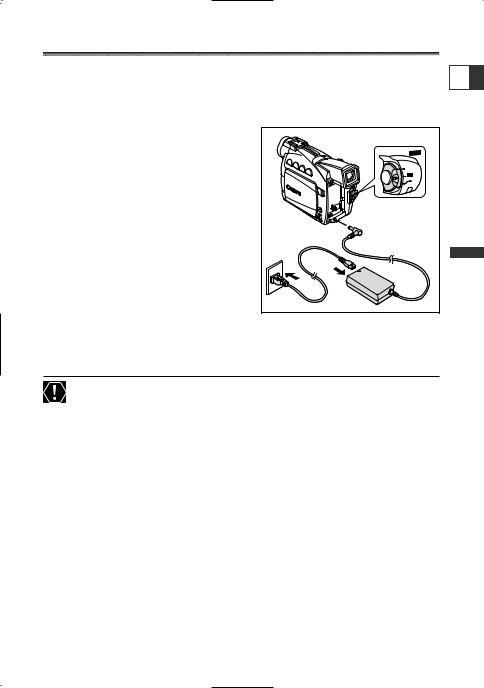
Using a Household Power Source
You can operate the camcorder from a household power source using the supplied
power adapter. The power adapter converts current from a power outlet (100-240 V AC, 50/60 Hz) to the DC current used by the camcorder.
E
1.Turn the POWER switch to OFF.
2.Connect the power cord to the power adapter.
3.Plug the power cord into a power outlet.
4.Connect the power adapter to the camcorder’s DC IN terminal.
POWER |
|
CAMERA |
|
OFF |
|
PLAY |
|
(VCR) |
|
r |
|
Basics the |
Mastering |
5.After use, disconnect the power adapter from the camcorder. Unplug the power cord from the power outlet and disconnect it from the adapter.
Turn off the camcorder before connecting or disconnecting the power adapter.
If the adapter is used close to a TV, it may cause picture interference. Move the adapter away from the TV or the antenna cable.
Do not connect any products that are not expressly recommended to the camcorder’s DC IN terminal or to the power adapter.
You may hear some noise from the power adapter during use. This is not a malfunction.
15
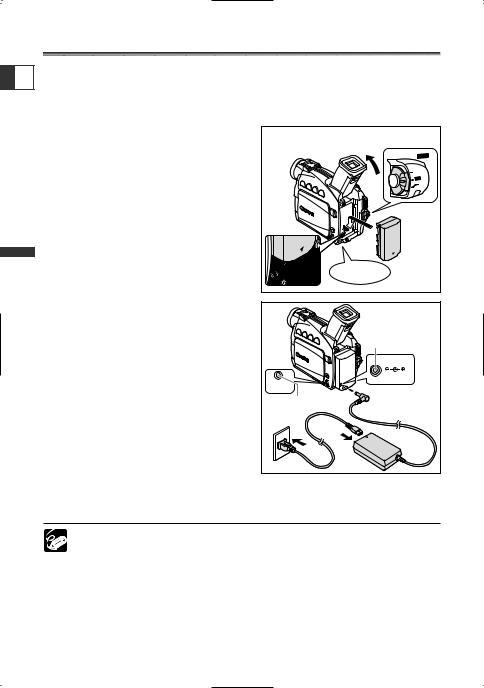
Attaching and Charging the Battery Pack
E
Charge the battery pack with the supplied power adapter before you use the
camcorder for the first time and subsequently when the message “CHANGE THE BATTERY PACK” appears.
Mastering the Basics
16
1. Turn the POWER switch to OFF. |
|
q |
|
2. Move the viewfinder upward. |
w |
||
POWER |
|||
|
|
||
3. Attach the battery pack to the |
|
CAMERA |
|
camcorder. |
|
OFF |
|
|
PLAY |
||
|
(VCR) |
||
|
|
||
• Remove the terminal cover of the battery |
|
|
|
pack. |
|
|
|
• Align the end of the battery pack with the |
|
|
|
line on the camcorder, press lightly and slide |
|
|
|
it in the direction of the arrow until it clicks. |
click |
|
|
|
|
4.Connect the power cord to the adapter.
5.Plug the power cord into a power outlet.
6.Connect the power adapter to the camcorder’s DC IN terminal.
7.When charging is complete, disconnect the power adapter from the camcorder. Unplug the power cord from the power outlet and disconnect it from the adapter.
8.Remove the battery pack after use.
DC IN terminal |
DC IN 8.4V |
CARD/ |
CHARGE |
CHARGE indicator y |
Press the BATT. button to remove the battery.
The battery pack may be defective when the CHARGE indicator flashes rapidly.The CHARGE indicator informs you about the charge status.
0-50%: Flashes once every second More than 50%: Flashes twice every second 100%: Glows steadily
Do not disconnect and reconnect the power cord while charging a battery pack. The battery pack may not be charged correctly even if the CHARGE indicator glows steady. The battery pack may also not be charged correctly
when a power outage occurs during charging. Remove the battery pack and attach it back to the camcorder.

Charging, Recording and Playback Time
Below times are approximate and vary according to the charging, recording or
playback conditions.
E
Charging Time
Battery Pack |
Charging Time |
|
|
|
|
BP-508 (ZR65 MC/ZR60) |
110 min. |
|
BP-512 |
(ZR70 MC/optional) |
120 min. |
|
|
|
BP-511 |
(Optional) |
120 min. |
BP-522 |
(Optional) |
210 min. |
BP-535 |
(Optional) |
310 min. |
|
|
|
•Charge the battery pack in temperatures between 41º F and 104º F (5º C and 40º C).
•A lithium ion battery pack can be charged at any charge state. Unlike conventional battery packs, you do not need to completely use or discharge it before charging.
Recording Time
Battery Pack |
Maximum Recording Time |
Typical Recording Time* |
|||
|
Using the Viewfinder |
Using the LCD |
Using the Viewfinder |
Using the LCD |
|
BP-508 |
100 min. |
75 min. |
55 min. |
40 min. |
|
(ZR65 MC/ZR60) |
|||||
|
|
|
|
||
|
|
|
|
|
|
BP-512 |
180 min. |
140 min. |
95 min. |
75 min. |
|
(ZR70 MC/optional) |
|||||
|
|
|
|
||
BP-511 (Optional) |
180 min. |
140 min. |
95 min. |
75 min. |
|
BP-522 (Optional) |
370 min. |
295 min. |
195 min. |
155 min. |
|
BP-535 (Optional) |
590 min. |
470 min. |
315 min. |
250 min. |
|
*Approximate times for recording with repeated operations such as start/stop, zooming, power on/off. Actual time may be shorter.
•We recommend that you prepare battery packs 2 to 3 times longer than you think you might need.
•To conserve battery charge, turn off the camcorder instead of leaving it in record pause mode.
Playback Time
Battery Pack |
Playback Time |
|
|
|
Using the LCD |
BP-508 (ZR65 MC/ZR60) |
70 min. |
|
BP-512 |
(ZR70 MC/optional) |
125 min. |
BP-511 |
(Optional) |
125 min. |
BP-522 |
(Optional) |
250 min. |
BP-535 |
(Optional) |
400 min. |
Mastering Basics the
17

How much power is left?
|
|
|
|
The battery symbols indicate the charge status of the battery |
|
|
|
|
|
|
|
||
|
|
|
|
|
|
|
|
|
|
||||
|
|
|
|
pack. |
|
|
|
|
|
|
|
|
|
|
E |
|
|
|
|
|
|
|
|
||||
|
|
When the battery pack is empty, “CHANGE THE BATTERY PACK” |
|
|
|
|
|
|
|
||||
|
|
|
|
|
|
|
|
|
|||||
|
|
|
|
appears for 4 seconds and |
|
starts flashing. |
|
|
|
|
|
|
|
|
|
|
|
|
|
|
|
|
|
|
|||
|
|
|
|
The battery charge indicators are not constant – they vary |
|
|
|
|
|
|
|
||
|
|
|
|
|
|
|
|
|
|
|
|||
|
|
|
|
|
|
|
|
|
|
|
|||
|
|
|
|
|
|
|
|
|
|
||||
|
|
|
|
according to the condition under which battery pack and |
|
|
|
|
|
|
|
||
|
|
|
|
camcorder are used. |
|
|
|
|
|
|
|
|
|
|
|
|
|
|
|
|
|
|
|
|
|||
|
|
|
|
Battery Pack Handling Precautions |
|||||||||
|
|
|
|
|
|
|
|
|
|
|
|
|
|
|
|
|
|
DANGER! |
|
|
|
|
|
|
|
|
|
|
|
|
|
Treat the battery pack with care. |
|||||||||
|
|
|
|
• Keep it away from fire (or it might explode.) |
|||||||||
Mastering |
Basicsthe |
|
|||||||||||
|
• Do not expose the battery pack to temperature higher than 140º F (60º C). Do |
||||||||||||
|
|
|
|
||||||||||
|
|
|
|
not leave it near a heater or inside a car in hot weather. |
|||||||||
|
|
|
|
• Do not try to disassemble or modify it. |
|||||||||
|
|
|
|
• Do not drop or knock it. |
|
|
|
|
|
|
|
|
|
|
|
|
|
• Do not get it wet. |
|
|
|
|
|
|
|
|
|
|
|
|
|
|
|||||||||
|
|
|
|
Charged battery packs continue to discharge naturally. Therefore, charge them on |
|||||||||
|
|
|
|
the day of use, or the day before, to ensure a full charge. |
|||||||||
|
|
|
|
Attach the terminal cover whenever a battery pack is not in use. Contact to metallic |
|||||||||
|
|
|
|
objects may cause a short circuit and damage the battery pack. |
|||||||||
|
|
|
|
Dirty terminals may cause a poor contact between the battery pack and the |
|||||||||
|
|
|
|
camcorder. Wipe the terminals with a soft cloth. |
|||||||||
|
|
|
|
Since storing a charged battery pack for a long time (about 1 year) can shorten its |
|||||||||
|
|
|
|
lifecycle or affect performance, we recommend to discharge the battery pack fully |
|||||||||
|
|
|
|
and to store it in a dry place at temperatures no higher than 86˚ F (30˚ C). If you do |
|||||||||
|
|
|
|
not use the battery pack for long periods, charge and discharge it fully at least once |
|||||||||
|
|
|
|
a year. If you have more than 1 battery pack, perform these precautions at the |
|||||||||
|
|
|
|
same time for all battery packs. |
|||||||||
|
|
|
|
Although the battery pack’s operating temperature range is from 32˚ F to 104˚ F |
|||||||||
|
|
|
|
(0˚ C to 40˚ C), the optimal range is from 50˚ F to 86˚ F (10˚ C to 30˚ C). At cold |
|||||||||
|
|
|
|
temperatures, performance will temporarily decline. Warm it in your pocket before |
|||||||||
|
|
|
|
use. |
|
|
|
|
|
|
|
|
|
|
|
|
|
Replace the battery pack if the usable time after full charge diminishes substantially |
|||||||||
|
|
|
|
at normal temperatures. |
|
|
|
|
|
|
|
|
|
18
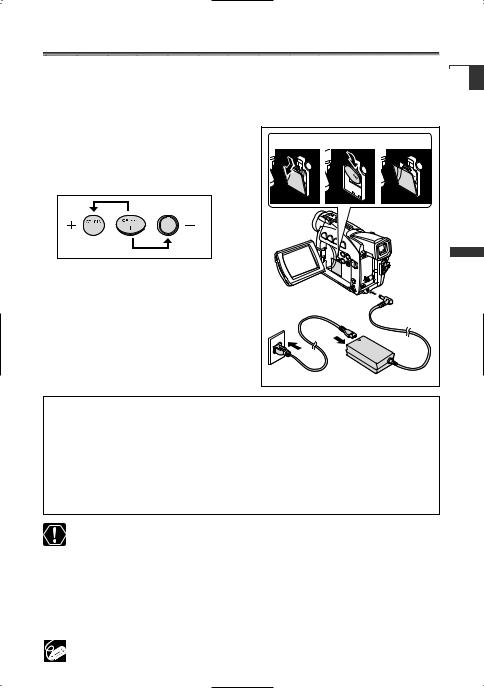
Installing the Backup Battery
The backup battery allows the camcorder to retain date, time and other camcorder
settings while the power source is disconnected. Power the camcorder from a household power source or with a battery pack when replacing the backup battery.
E
1. |
Open the backup battery cover. |
q |
w |
e |
|
2. |
Insert the lithium battery with the |
|
|||
|
|
|
|
||
|
+ side facing outward. |
|
|
|
|
3. |
Close the cover. |
|
|
|
|
|
|
|
|
Basics the |
Mastering |
WARNING!
•The battery used in this device may present a fire or chemical burn hazard if mistreated. Do not recharge, disassemble, heat above 212° F (100° C) or incinerate the battery.
•Replace the battery with a CR1616 made by Panasonic, Hitachi Maxell, Sony, Toshiba, Varta or Renata. Use of other batteries may present a risk of fire or explosion.
Do not pick up the battery using tweezers or other metal tools as this will cause a short circuit.
Wipe the battery with a clean dry cloth to ensure proper contact.
Keep the battery out of reach of children. If it is swallowed, seek medical assistance immediately. The battery case may break and the battery fluids may damage stomach and intestines.
Do not disassemble, heat or immerse the battery in water to avoid the risk of explosion.
The backup battery has a life span of about a year. j flashes to inform you that
it needs to be replaced. |
19 |
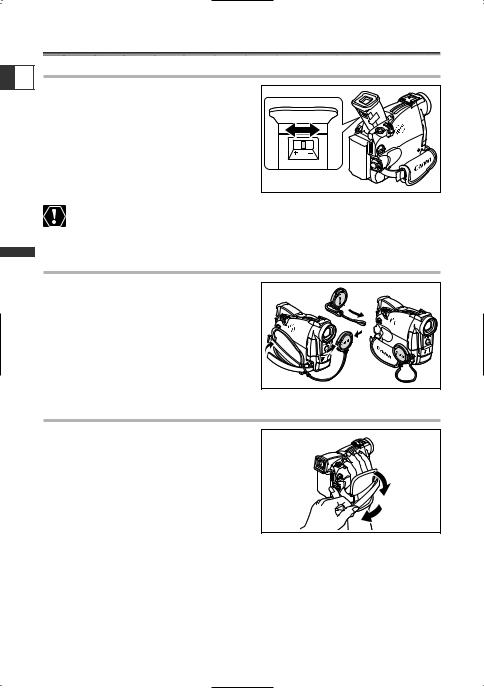
Preparing the Camcorder
EAdjusting the Viewfinder (Diopter Adjustment)
1. Turn on the camcorder and keep the LCD panel closed to adjust the viewfinder.
2. Adjust the diopter adjustment lever.
Do not leave the viewfinder exposed to direct sunlight as it may melt (due to concentration of light by the lens). Adjust the angle of the viewfinder to prevent sunlight from entering.
Mastering the Basics
Attaching the Lens Cap
1.Attach the cord to the lens cap.
2.Pass the grip belt through the loop on the cord.
Press the buttons on the lens cap when attaching/removing it. Hook the lens cap on the grip belt while you are recording, and place it over the lens when you have finished.
Fastening the Grip Belt
Hold the camcorder with your right hand and adjust the belt with your left.
Adjust the grip belt so that you can reach the zoom lever and photo button with your index finger, and the start/stop button with your thumb.
20
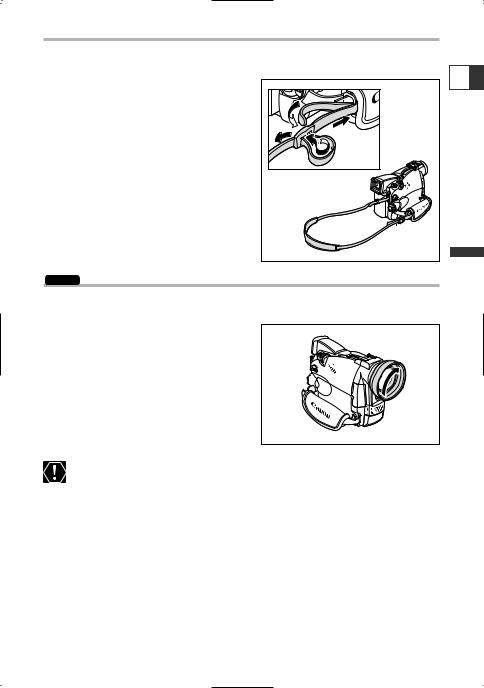
Attaching the Shoulder Strap
For extra security and portability, attach the shoulder strap before using the
camcorder.
Pass the ends through the strap mount and adjust the length of the strap.
ZR70 MC Mounting the Wide Attachment
The WA-30.5 Wide Attachment gives you a wide perspective for indoor shots or panoramic views (0.6×). The wide attachment is for use at maximum wide-angle.
Screw the wide attachment fully into the lens filter thread.
If you zoom to telephoto, the picture will not be in focus.
Do not look directly at the sun or other strong light sources through the wide attachment. It could damage your eyesight.
When recording in wide angle with the wide attachment, the outer periphery of the image may become curved.
Filters cannot be used with the wide attachment.
If dust accumulates on the wide attachment or on the camcorder lens, clean both lenses gently with a blower brush.
The wide attachment may obstruct the remote sensor (the range of the wireless controller narrows), or may cause a shadow to appear on the picture when recording with a video light or the assist lamp (White LED).
Do not touch the lens to avoid smudges and fingerprints.
Do not store the wide attachment in a humid place as it may mold.
E
Mastering Basics the
21
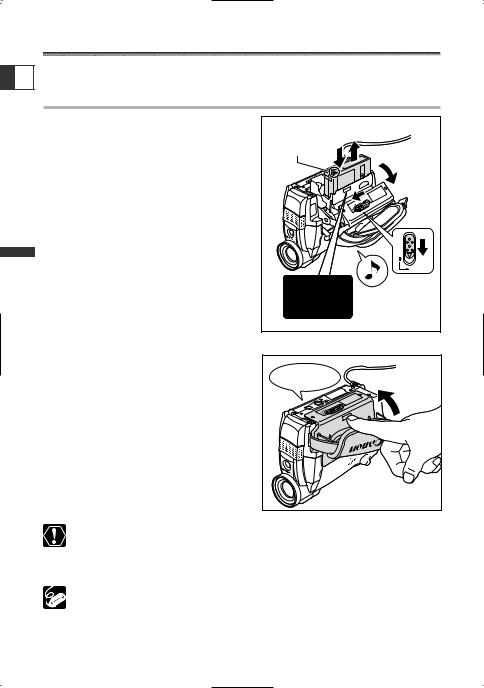
Loading a Cassette
Use only videocassettes marked with the D logo.
E
Mastering the Basics
Loading and Unloading
1. Slide and hold the OPEN/EJECT |
|
|
switch and open the cassette |
Tape |
w |
compartment cover. |
protection tab |
q |
The cassette compartment opens |
|
|
|
|
|
automatically. |
|
|
2. Load/unload the cassette. |
|
|
• Load the cassette with the window facing |
|
|
the grip belt and the REC/SAVE tab facing |
|
OPEN/EJECT |
upward. |
|
|
• Unload the cassette by pulling it straight |
|
|
out. |
e |
|
|
|
|
3. Press the P mark on the cassette |
|
|
compartment until it clicks. |
|
|
Wait for the cassette compartment to retract |
|
|
automatically. |
|
|
4. Close the cassette compartment |
|
|
cover. |
click |
|
|
|
r |
Do not interfere with the cassette compartment while it is opening or closing automatically or attempt to close the cover until the cassette compartment has fully retracted.
Be careful not to get your fingers caught in the cassette compartment cover.
If the camcorder is connected to a power source, cassettes can be loaded/unloaded even if the POWER switch is set to OFF.
v flashes if no cassette is inserted when turning on the power (in CAMERA and PLAY (VCR) mode).
With some types of tapes, the remaining tape display may not be accurate.
22

Protecting Tapes from Accidental Erasure |
|
|
To protect your recordings from accidental |
|
|
erasure, slide the tab on the cassette to the |
|
E |
left. (This switch position is usually labeled |
|
|
|
|
|
SAVE or ERASE OFF.) |
REC |
|
If you load a protected cassette in CAMERA |
REC |
|
SAVE |
SAVE |
|
|
|
|
mode, the message “THE TAPE IS SET FOR |
|
|
ERASURE PREVENTION” appears for approx. 4 |
|
|
seconds and v starts flashing. If you wish to record on that cassette, slide the tab |
||
back to the right. |
|
|
Cassette Handling Precautions
Rewind tapes after use. If the tape becomes slack and damaged, it may cause picture and sound distortion.
Return cassettes in the case and store them upright. |
|
|
Mastering Basicsthe |
||
damage the camcorder. |
||
Do not leave the cassette in the camcorder after use. |
|
|
Do not use cassettes with spliced tapes or nonstandard cassettes as they may |
|
|
Do not insert anything into the small holes of the cassette, or cover them with |
|
|
cellophane tape. |
|
|
Handle cassettes with care. Do not drop or subject them to severe impact as this |
|
|
may damage the cassettes. |
|
|
Rewind tapes from time to time if they are stored for a long time. |
|
|
With cassettes equipped with a memory function, metal plated terminals may |
|
|
become dirty with use and the cassette’s memory function may not work properly. |
|
|
Clean the terminals with a cotton swab after about 10 times of loading/unloading. |
|
23
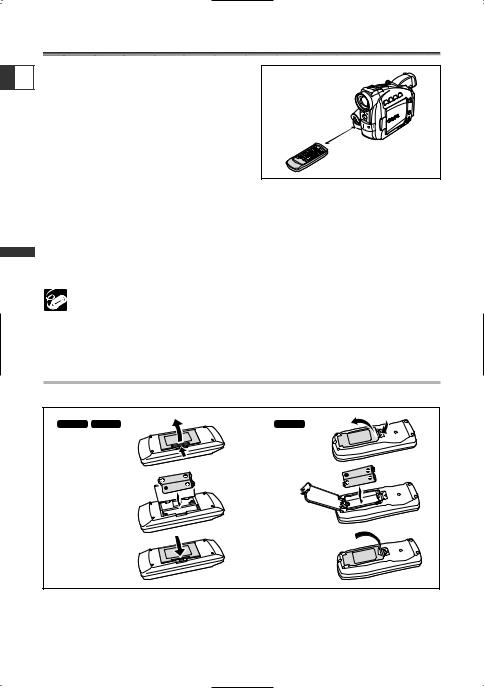
E
Mastering the Basics
Using the Wireless Controller
You can operate the camcorder with the supplied wireless controller from a distance of up to 16 feet (5 m). Point it at the camcorder’s remote sensor when you press the buttons.
Following functions cannot be operated without the wireless controller:
•Some special playback modes ( 38)
38)
•Photo/date search ( 85)
85)
•Zero set memory ( 86)
86)
•Analog line-in ( 89)
89)
•DV dubbing ( 90)
90)
•AV Insert ( 94)
94)
•Audio dubbing ( 96)
96)
The wireless controller may not work properly in bright places, such as outdoors under direct sunlight, or when used too close to the camcorder.
The operable range of the wireless controller may shorten when the camcorder’s remote sensor is exposed to strong light.
When the batteries run out, replace both at the same time.
Inserting Batteries
The wireless controller operates with two AA batteries.
ZR70 MC ZR65 MC
WL-D79
q |
ZR60 q |
|
WL-D80 |
w |
w |
e |
e |
1.Open the battery cover.
2.Insert the batteries following the + and – markings.
3.Close the battery cover.
24
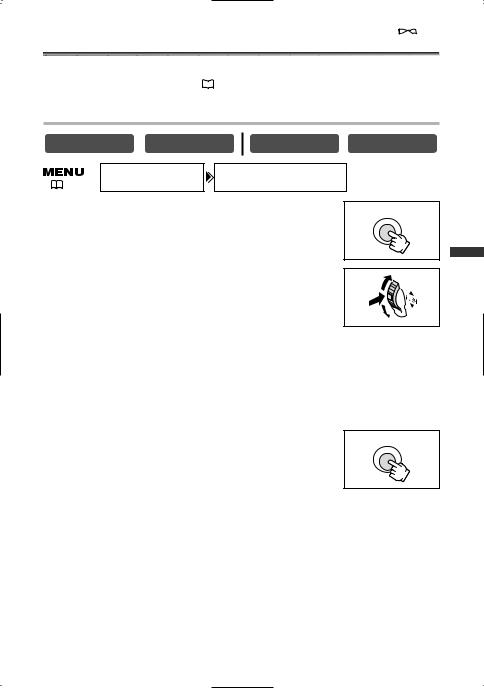
Setting the Time Zone, Date and Time 

Set the time zone, date and time when you first start using your camcorder. Install the |
E |
|
||
backup battery before you begin ( |
|
19). |
|
|
|
|
|||
Setting the Time Zone/Daylight Saving Time
CAMERA |
PLAY (VCR) |
CARD CAMERA |
SYSTEM |
|
T.ZONE/DST•••N.Y. |
( |
44) |
1.Press the MENU button to open the menu.
2.Turn the selector dial to select [SYSTEM] and press the selector dial.
3.Turn the selector dial to select [T.ZONE/DST] and press the selector dial.
CARD PLAY (VCR)
MENU
•The time zone setting appears.
•The default setting is New York. Select your time zone and daylight saving time (DST) setting if necessary.
4.Turn the selector dial to select the setting option that represents your time zone.
To adjust for daylight saving time, select the time zone with the U next to the area.
5.Press the MENU button to close the menu.
MENU
Mastering Basics the
25
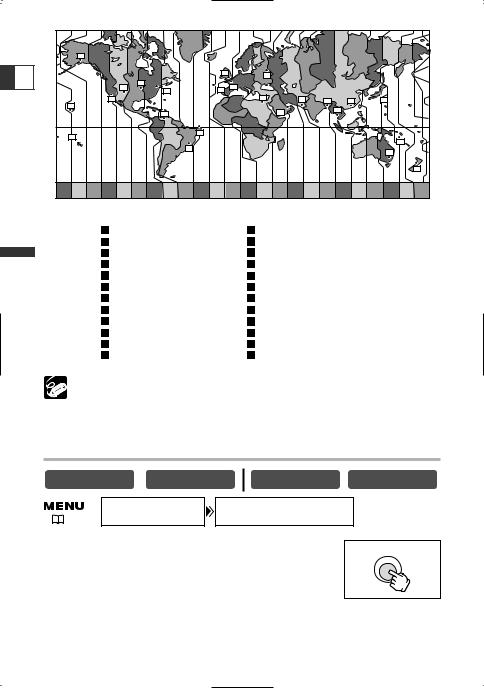
E
16 |
|
|
|
|
|
|
|
|
|
|
|
|
|
|
|
|
|
|
|
1 |
|
|
4 |
|
|
|
|
|
|
|
|
|
|
|
|
|
|
|
|
|
|
|
|
|
|
|
|
|
19 |
|
|
|
2 |
|
|
|
|
|
|
|
|
|
|
|
18 |
20 |
|
24 |
|
|
|
|
|
|
|
|
|
|
|
|
|
|
|
|
|
|
|
|
|
|
|
|
|
||
|
17 |
|
|
|
|
|
3 |
|
|
6 |
7 |
|
9 |
|
10 |
15 |
|
|
|
|
|
|
|
|
|
|
|||||
|
|
|
|
|
|
|
|
|
|
|
8 |
|
|
|
|
|
|
21 |
|
|
|
|
|
5 |
|
|
|
|
|
|
|
|
|
|
|
|
|
|
|
|
|
|
|
|
|
||
|
|
|
|
|
|
|
|
|
|
|
|
|
|
|
|
14 |
|
|
|
23 |
|
|
|
|
|
|
|
|
|
|
|
|
|
|
|
|
|
|
|
|
|
|
|
|
|
12 |
|
|
|
|
|
|
|
|
|
|
|
|
|
|
|
|
|
|
|
|
22 |
|
|
|
|
|
|
|
|
|
|
|
11 |
|
|
|
|
|
|
|
|
|
|
|
|
|
|
|
|
|
|
|
|
|
|
|
|
|
|
|
|
|
|
|
13 |
14 15 |
16 17 18 19 |
20 21 |
22 |
23 24 |
1 |
2 |
3 |
4 |
5 |
6 |
7 |
8 |
9 |
10 |
11 12 13 |
Mastering the Basics
No. |
Time zone |
No. |
Time zone |
|
LONDON |
|
WELLGTN (Wellington) |
|
PARIS |
|
SAMOA |
|
CAIRO |
|
HONOLU. (Honolulu) |
|
MOSCOW |
|
ANCHOR. (Anchorage) |
|
DUBAI |
|
L.A. (Los Angeles) |
|
KARACHI |
|
DENVER |
|
DACCA |
|
CHICAGO |
|
BANGKOK |
|
N.Y. (New York) |
|
H. KONG (Hong Kong) |
|
CARACAS |
|
TOKYO |
|
RIO (Rio de Janeiro) |
|
SYDNEY |
|
FERNAN. (Fernando de Noronha) |
|
SOLOMON |
|
AZORES |
Once you have set time zone, date and time, you do not need to reset the clock each time you travel to another time zone. Just set the time zone to the one of your destination, and the camcorder automatically adjusts the clock.
Days per month and leap years will be automatically adjusted.
Setting the Date and Time
CAMERA |
PLAY (VCR) |
CARD CAMERA |
CARD PLAY (VCR) |
SYSTEM |
|
D/TIME SET•••JAN. 1,2003 |
|
( 44) |
|
12:00 PM |
|
1. Press the MENU button to open the menu. |
MENU |
||
|
|
|
|
26
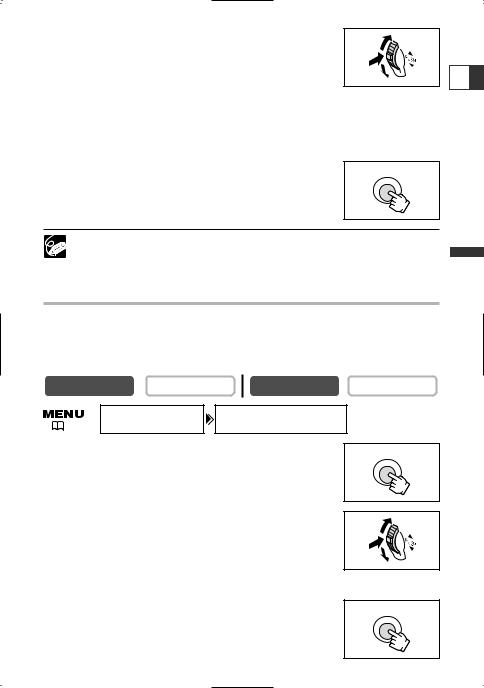
2. Turn the selector dial to select [SYSTEM] and press the selector dial.
3. Turn the selector dial to select [D/TIME SET] and press the selector dial.
The year display starts to flash.
4. Turn the selector dial to select the year, and press the selector dial.
• The next part of the display starts flashing.
• Set the month, day, hours and minutes in the same way.
5. Press the MENU button to close the menu and to
MENU
start the clock.
Time zone, date and time appear for 4 seconds each time you turn the power on.
To change a part of the date or time, press the selector dial at step 4, and move to the part you wish to change.
The date can be set to any year between 2003 and 2030.
Displaying Date and Time during Recording
You can display time zone, date and time in the lower left corner of the screen (the time zone disappears after 4 seconds). The 4-second display will no longer appear when you turn the power on. The date and time display will not be superimposed on your recordings.
CAMERA |
PLAY (VCR) |
CARD CAMERA |
DISPLAY SET UP |
D/T DISPLAY••OFF |
|
( 44) |
|
|
1.Press the MENU button to open the menu.
2.Turn the selector dial to select [DISPLAY SET UP] and press the selector dial.
3.Turn the selector dial to select [D/T DISPLAY] and press the selector dial.
4.Turn the selector dial to select [ON].
5.Press the MENU button to close the menu.
CARD PLAY (VCR)
MENU
MENU
E
Mastering Basics the
27
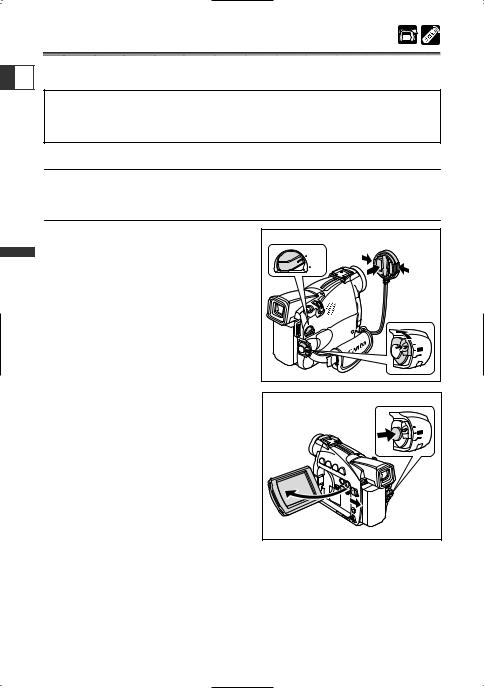
Recording Movies on a Tape
You can use the LCD screen or the viewfinder when recording.
E
Before You Begin Recording
Make a test recording first to check if the camcorder operates correctly. Before you make important recordings, clean the video heads ( 142).
142).
Preparations
Connect a power source. Load a cassette.
Mastering the Basics
28
Recording
1.Remove the lens cap.
2.Set the camcorder to CAMERA mode.
If you have not set the time zone, date and time, “SET THE TIME ZONE, DATE AND TIME” appears. See Setting the Time Zone, Date and Time (  25).
25).
3.Open the LCD panel ( 32).
32).
To use the viewfinder, keep the LCD panel closed or rotate it so that the screen faces in the same direction of the lens (  33).
33).
4.Press the start/stop button to begin recording.
Wait until the tape counter came to a complete stop before you begin recording.
5.Press the start/stop button again to pause recording.
ZR70 MC/ZR65 MC |
|
TAPE |
q |
CARD |
|
|
w |
|
CAMERA |
|
OFF |
|
PLAY |
|
(VCR) |
|
r t |
CAMERA
OFF PLAY (VCR)
Restart recording by pressing the start/stop button.

When You Have Finished Recording
1.Turn the POWER switch to OFF.
2.Close the LCD panel.
3.Replace the lens cap.
4.Unload the cassette.
5.Disconnect the power source.
When recording outdoors or through a window, do not leave LCD screen, viewfinder or lens exposed to direct sunlight as it may cause damage.
Turn the power off if you do not intend to use the camcorder for a longer time.
The camcorder will shut off after 5 minutes when left in record pause mode to protect tape and video heads. To continue recording, turn the POWER switch
to OFF and then back to CAMERA.
For when to use the [ (Easy Recording) or Q (program AE) mode, see Using
the Recording Programs ( |
57). |
When you do not remove the cassette, you can record the next scene without producing any noise or blank sections between the recordings even if you turn the camcorder off.
About the built-in microphone: When recording near loud sounds (such as fireworks, drums or concerts), sound may become distorted or may be
recorded not in the actual sound level. |
|
For extra recording time, see Changing the Recording Mode ( |
54). |
E
Mastering Basics the
29
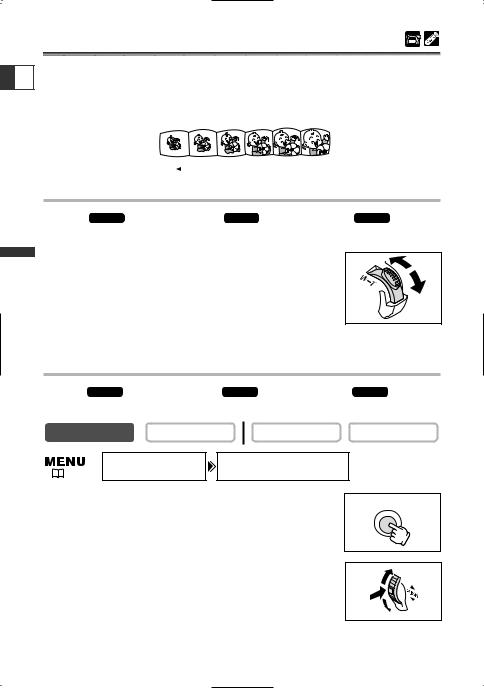
Zooming
E
The camcorder’s zoom lens allows you to choose the best picture angle for your
recordings. The camcorder automatically switches between optical zooming and digital zooming. Image resolution is slightly lower with the digital zoom.
Zoom in  T
T
Mastering the Basics
W |
|
Zoom out |
|
|
|
|
|||
Optical Zoom |
|
|
|
|
|
|
|
|
|
ZR70 MC |
|
ZR65 MC |
ZR60 |
|
22× optical zoom |
|
20× optical zoom |
18× optical zoom |
|
Move the zoom lever toward W to zoom out (wideangle). Move it toward T to zoom in (telephoto).
• Press the zoom lever slightly for a slow zoom. Press harder for a faster zoom.
•You can also use the T and W buttons on the wireless controller. However, you cannot control the zoom speed.
Digital Zoom
ZR70 MC |
ZR65 MC |
ZR60 |
|
|
|
88×/440× digital zoom |
80×/400× digital zoom |
72×/360× digital zoom |
CAMERA |
PLAY (VCR) |
CARD CAMERA |
CAMERA SET UP |
D.ZOOM••••••••88× |
|
( 44) |
|
|
1.Press the MENU button to open the menu.
2.Turn the selector dial to select [CAMERA SET UP] and press the selector dial.
3.Select [D.ZOOM] and press the selector dial.
4.Select a setting option.
CARD PLAY (VCR)
MENU
30
